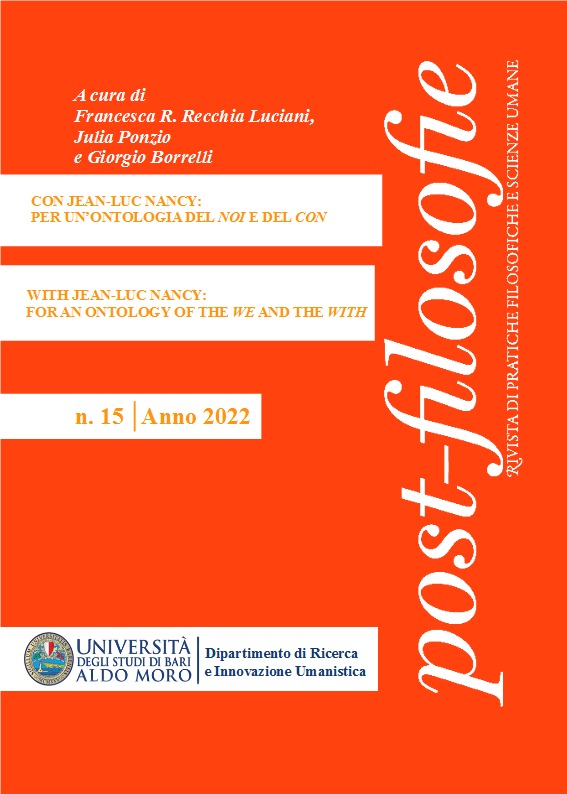El arte sin fin tras la muerte del arte
DOI:
https://doi.org/10.15162/1827-5133/1828Keywords:
Arte preistorica, Estetica, Hegel, Jean-Luc Nancy, Simbolo, Aestehetics, Prehistoric Art, Symbol, Arte prehistórico, Estética, SímboloAbstract
Este artículo parte de la teoría del símbolo de la Estética hegeliana para mostrar cómo su aplicación al arte prehistórico no podía sino conducir a la conclusión de que aquellas manifestaciones quedaban en buena medida fuera de lo artístico. Frente a esta idea, el pensamiento del filósofo Jean-Luc Nancy ofrece una mirada distinta sobre el arte prehistórico, trazando una línea de continuidad entre los muchos interrogantes que abren las marcas, dibujos y signos de aquel periodo, y el arte contemporáneo, ese que viene después de la hegeliana “muerte del arte”, y que mantiene las mismas preocupaciones por la relación entre sentido y significación en unas imágenes que siguen poseyendo el carácter enigmático que Hegel señalara en las más primitivas.
This paper article starts from the symbol theory of Hegelian Aesthetics to show how its application to prehistoric art could only lead to the conclusion that those manifestations were largely outside of the artistic. Faced with this idea, the thought of the philosopher Jean-Luc Nancy offers a different look at prehistoric art, drawing a line of continuity between the many questions that open the marks, drawings and signs of that period, and contemporary art, that which it comes after the Hegelian “death of art”, and that maintains the same concerns about the relationship between sense and signification in images that continue to possess the enigmatic character that Hegel pointed out in the most primitive ones.
References
BATAILLE G., Lascaux o el nacimiento del arte [trad. esp. de Isidro Herrera y Meritxell Martínez], Arena Libros, Madrid 2013.
DANTO A., Después del fin del arte. El arte contemporáneo y el linde de la historia [trad. esp. de Elena Neerman Rodríguez], Paidós, Barcelona 2010.
DERRIDA, J., Márgenes de la filosofía [trad. esp. de Carmen González Marín], Cátedra, Madrid 1989.
HEGEL G.W.F., Estética, vol. I [trad. esp. de Raúl Gabás], Península, Barcelona 1989.
—, Enciclopedia de las ciencias filosóficas [trad. esp. de Ramón Valls Plana], Alianza, Madrid 2005.
—, Filosofía del arte o Estética [trad. esp. de Domingo Hernández Sánchez], Abada, Madrid 2006.
LEROI-GOURHAN L., Símbolos, Artes y Creencias de la Prehistoria [trad. esp. de José Manuel Gómez-Tabanera], Istmo, Madrid 1984.
NANCY J.-L., Corpus, Métailié, Paris 2000.
—, Les Muses, Galilée, París, 2001.
—, “L’a-athéisme”, en «ah!» n° 3 (abril 2006), Bruselas.
—, Lugares divinos seguido de Cálculo del poeta [trad. esp. de Jordi Massó Castilla y Cristina Rodríguez Marciel], Arena Libros, Madrid 2014.
—, Tàpies - L’âme au corps, TER, Mauvezin 2015.
— y LEBRE J., Signaux sensibles. Entretien à propos des arts, Bayard, Montrouge 2017.
Downloads
Published
Issue
Section
License
“Post-Filosofie” utilizza Open Journal Systems 2.4.8.5, che è un software open source per la gestione e la pubblicazione di riviste sviluppato, supportato e distribuito gratuitamente dal Public Knowledge Project sotto la GNU General Public License.
Gli autori che pubblicano su questa rivista accettano le seguenti condizioni:
- Gli autori mantengono i diritti sulla loro opera e cedono alla rivista il diritto di prima pubblicazione dell'opera, contemporaneamente licenziata sotto una Licenza Creative Commons - Attribuzione che permette ad altri di condividere l'opera indicando la paternità intellettuale e la prima pubblicazione su questa rivista.
- Gli autori possono aderire ad altri accordi di licenza non esclusiva per la distribuzione della versione dell'opera pubblicata (es. depositarla in un archivio istituzionale o pubblicarla in una monografia), a patto di indicare che la prima pubblicazione è avvenuta su questa rivista.
- Gli autori possono diffondere la loro opera online (es. in repository istituzionali o nel loro sito web) prima e durante il processo di submission, poichè può portare a scambi produttivi e aumentare le citazioni dell'opera pubblicata (Vedi The Effect of Open Access).
"Post-Filosofie" uses Open Journal Systems 2.4.8.5, which is an open source journal management and publication software developed, supported and distributed free of charge by the Public Knowledge Project under the GNU General Public License.
Authors publishing in this journal accept the following conditions:
- Authors retain the rights to their work and assign to the journal the right of first publication of the work, simultaneously licensed under a Creative Commons Licence - Attribution that allows others to share the work indicating intellectual authorship and first publication in this journal.
- Authors may enter into other non-exclusive licensing agreements to distribute the published version of the work (e.g., deposit it in an institutional repository or publish it in a monograph), as long as they indicate that the first publication was in this journal.
- Authors may disseminate their work online (e.g. in institutional repositories or on their website) before and during the submission process, as it may lead to productive exchanges and increase citations of the published work (See The Effect of Open Access).







